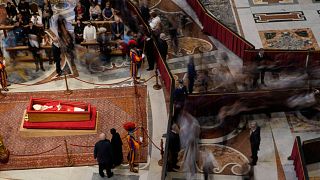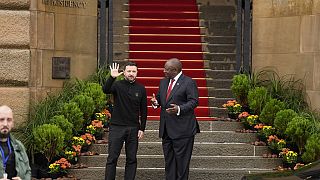Museum
A unique medieval scroll is going on display for the first time in Jerusalem at the Israel Museum.
The scroll, about 11 meters (36 feet) long, is a one-of-a-kind illustrated travelogue depicting the pilgrimage of an Egyptian-Jew during the 14th century to the Land of Israel.
Written in Hebrew, the travelogue documents religious sites through some 130 illustrations.
"All the travelogues we know today are written travelogues," says Dr. Rachel Sarfati, Chief Curator of the Israel Museum's Wing for Jewish Art and Life.
"This is the only painted travelogue we know among Christian travel logs, Muslim travelogues, and Jewish travelogues. So, this is a unique manuscript, very special and as far as I know, the only one with the story that tells us through illustrations, through visual language and not textual language."
The scroll is named after the city of Florence because it is housed in the National Central Library of Florence.
And even from abroad, the institution is still looking after the scroll.
"We have via zoom people of the National Library in Florence watching the process of putting the scroll in the showcase," says Sarfati.
According to the Israel Museum, this artefact is the second oldest document still in existence offering such a detailed portrayal of the Land of Israel.
The illustrations range from Egypt to Lebanon, giving an insight into what the region looked like over seven centuries ago.
"From a historical point of view there is significant evidence of the actual view of the Holy Sites here, about historical events, and some enigmatic questions in the research of the history of the land of Israel can find there solutions through the illustrations of this scroll," says Sarfati.
The central part of the scroll, about two meters in length (seven feet), portrays the Jewish holy site, Temple Mount - which Muslims call the Haram el Sharif, the Noble Sanctuary -; the location of the Al-Aqsa mosque and the iconic Golden Dome.
The Golden Dome is built over the rock where Jews and Muslims believe Biblical Abraham prepared to sacrifice his son Isaac, or Ishmael in Muslim tradition.
"We can find some details about him (the scroll's painter) through the inscriptions and through some words he wrote about himself," says Sarfati.
"So, we know that he was an Egyptian-Jew, that his profession was a painter, because he wrote in a small inscription, accompanying the illustration of Moses' Rock - we know this place in Petra (Jordan) till our days - there he wrote: 'I am the painter, drank of the water of Moses Rock.' So we know many things. We know that he did this scroll by himself, if he wrote that he drank from the water of Moses Rock, we know that he did his journey from Egypt to the Land of Israel."












Go to video
Paris hosts the 4th edition of African Cinema Days featuring Côte d'Ivoire
Go to video
Pamela's iconic 'Baywatch' swimming costume makes a splash at new exhibit
02:17
Goma’s cultural scene struggles amid ongoing conflict
02:18
Casablanca Memory Museum celebrates city’s history
02:20
Human Rights Festival highlights global efforts and Fulani struggles
02:41
Millions across South Asia celebrate the Hindu festival of colours, love, and Spring